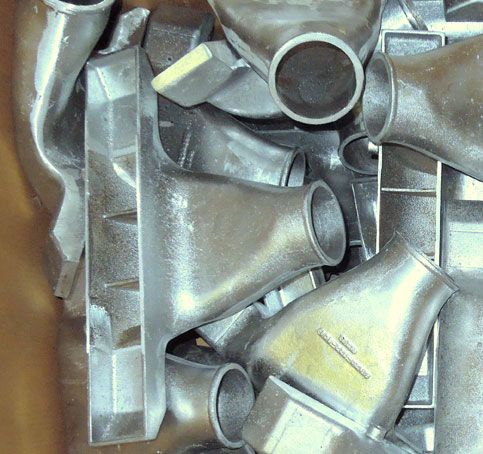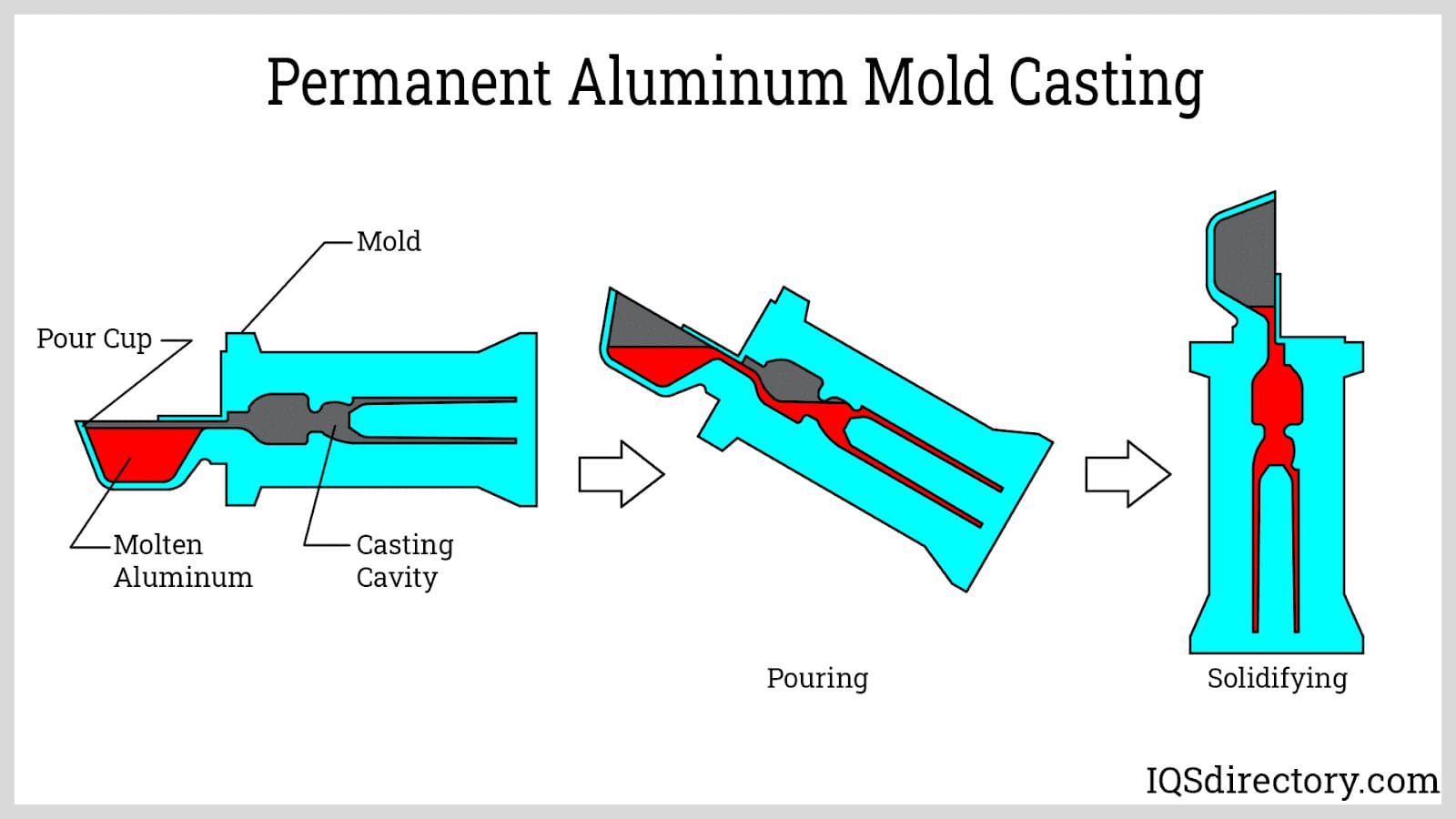Discover how Aluminum Foundry operations deliver consistent results
Wiki Article
Discovering the Perks and Practical Use Aluminum Castings in Today's Market
Light weight aluminum castings have actually become increasingly relevant in different sectors due to their one-of-a-kind qualities. Their light-weight nature and resistance to corrosion make them ideal for requiring applications. In addition, the premium strength-to-weight proportion supplies substantial benefits in design and manufacturing. As industries remain to explore their potential, the full extent of aluminum spreadings' applications and benefits remains to be totally discovered. What exists ahead for this flexible product?The Lightweight Benefit of Light Weight Aluminum Castings
Several materials are utilized in manufacturing, aluminum spreadings stand out largely due to their light-weight buildings. This particular makes aluminum spreadings an attractive option for various markets, especially in aerospace and automotive applications, where weight reduction is essential for boosting fuel efficiency and efficiency. The light-weight nature of aluminum permits producers to create components that are simpler to deal with and mount, inevitably minimizing labor prices.Moreover, the capability to produce complex forms without substantial weight charges makes it possible for developers to innovate while keeping architectural stability. Aluminum spreadings can effectively change larger products, leading to significant savings in shipping and operational prices. Their lightweight benefit likewise contributes to boosted product long life, as lighter elements frequently cause reduced deterioration on machinery. In general, the lightweight buildings of aluminum castings provide makers with an one-upmanship, cultivating innovations in item style and performance throughout various markets.

Remarkable Corrosion Resistance
Aluminum castings have an all-natural resistance to oxidation, which significantly boosts their longevity in numerous atmospheres. This integral residential property not only contributes to their durability but also aligns with the lightweight benefit that aluminum supplies. Therefore, aluminum spreadings are progressively recognized for their exceptional rust resistance in many applications.
Naturally Resistant to Oxidation
Among the standout qualities of light weight aluminum spreadings is their exceptional deterioration resistance, which stems from a natural oxidation procedure. When subjected to air, aluminum reacts to create a thin, protective layer of aluminum oxide. This layer acts as a barrier against more oxidation and shields the underlying metal from harsh aspects such as dampness and salts. Unlike other metals, this oxide layer is self-repairing; if damaged, it quickly reforms when exposed to air. This one-of-a-kind residential or commercial property enhances the long life of aluminum castings in numerous environments, making them suitable for applications in markets such as aerospace, automobile, and marine. The natural resistance to oxidation substantially minimizes upkeep expenses and increases the integrity of light weight aluminum spreadings in requiring conditions.Light-weight Sturdiness Advantage
The lightweight nature of light weight aluminum spreadings adds significantly to their sturdiness, making them a useful selection in numerous industries. This remarkable longevity is mainly attributed to aluminum's innate resistance to corrosion, which is boosted further via anodizing and other surface therapies. Unlike lots of metals, light weight aluminum does not corrosion; instead, it develops a protective oxide layer that guards it from environmental damages. This residential property is especially beneficial in sectors such as vehicle and aerospace, where weight decrease is vital without compromising stamina. In addition, the long life of aluminum castings decreases upkeep prices and substitutes, providing financial advantages gradually. Their lightweight sturdiness and corrosion resistance position light weight aluminum castings as a remarkable product for modern production applications.
Superior Strength-to-Weight Proportion
A remarkable feature of aluminum spreadings is their superior strength-to-weight proportion, which makes them extremely desirable in numerous applications. This inherent property enables aluminum spreadings to endure considerable anxiety while continuing to be lightweight, an essential variable in markets such as aerospace, vehicle, and production. Engineers typically favor light weight aluminum castings for parts that need both longevity and minimized weight, improving fuel effectiveness and efficiency.The high strength-to-weight ratio additionally promotes the layout of complex shapes and structures, making light weight aluminum spreadings versatile for complicated applications. In addition, the ability to maintain architectural integrity under tough problems guarantees long life and reliability in items, from aircraft frameworks to auto parts. This advantage contributes to the expanding fad of utilizing aluminum spreadings in cutting-edge layouts, ultimately leading to boosted performance and effectiveness throughout varied industries. The superior strength-to-weight ratio of light weight aluminum spreadings positions them as a crucial material in modern-day engineering and manufacturing.
Cost-Effectiveness in Manufacturing
Cost-effectiveness in aluminum casting production is primarily accomplished with reduced product waste and efficient manufacturing processes. By maximizing designs and making use of advanced strategies, suppliers can reduce excess product use while keeping top quality requirements. This method not only lowers production expenses yet likewise adds to more sustainable methods within the sector.Lowered Product Waste
Decreasing material waste in light weight aluminum spreading procedures greatly improves production effectiveness. By optimizing the layout and manufacturing strategies, firms can minimize excess scrap and improve resource application. This decrease in waste not just lowers material expenses but additionally contributes to a more sustainable manufacturing model. The capacity to recycle aluminum additional assistances cost-effectiveness, allowing makers to reclaim and reuse products without compromising top quality. As the sector progressively focuses on sustainability, decreased product waste aligns with environmental goals while at the same time increasing productivity. Ultimately, reliable use basic materials strengthens the affordable placement of companies on the market, making aluminum castings a beneficial choice in numerous applications. The critical method to minimizing waste mirrors a commitment to both financial and environmental duty.Reliable Production Processes
While standard production procedures can sustain significant expenses, aluminum casting supplies a much more reliable option that enhances total manufacturing productivity. This approach decreases product waste and enables for specific control over the manufacturing procedure, resulting in decreased labor and operational prices. The ability to generate complex shapes with less actions additionally improves manufacturing, adding to much shorter preparations. Additionally, light weight aluminum's lightweight nature and superb thermal conductivity permit energy cost savings throughout production and in the final application. By using modern casting technologies, manufacturers can achieve higher throughput without giving up high quality. As a result, aluminum spreading stands apart as an economical solution, making it an eye-catching choice for businesses intending to enhance their manufacturing processes in today's open market.Adaptability Across Industries
Light weight aluminum castings show impressive flexibility throughout numerous sectors, as they can be customized to satisfy specific requirements and applications. In the vehicle sector, light weight aluminum spreadings are made use of in engine blocks, transmission real estates, and wheels, using lightweight yet sturdy options that improve gas performance. The aerospace industry additionally takes advantage of aluminum castings, using them in structural components and engine components because of their strength-to-weight proportion.In the customer products field, manufacturers use aluminum castings for items ranging from kitchenware to furnishings, supplying both visual appeal and capability. The electronic devices market uses aluminum castings for housings and warmth sinks, guaranteeing reliable thermal management. Additionally, the building sector leverages light weight aluminum spreadings for structural components and architectural components, enhancing durability and design adaptability. This wide applicability highlights light weight aluminum spreadings as a vital resource, meeting the diverse needs of various markets while maintaining high performance and reliability.
Sustainability and Ecological Impact
As sectors significantly focus on sustainable methods, light weight aluminum castings become an environment-friendly selection as a result of their recyclability and reduced ecological impact. Aluminum is among one of the most recycled products globally, with the ability to be repurposed multiple times without degradation of top quality. This characteristic greatly lowers the demand for resources and energy usage connected with primary light weight aluminum manufacturing, which is energy-intensive.Furthermore, aluminum spreadings add to lightweight layouts, bring about fuel efficiency in transport applications such as automotive and aerospace industries. Their longevity and resistance to rust extend product lifespans, even more decreasing waste and resource use gradually. Several producers are adopting liable sourcing and environmentally pleasant production methods, enhancing the sustainability of light weight aluminum spreading processes. In general, light weight aluminum castings represent a functional service for services aiming to reduce their environmental influence while achieving performance and efficiency.
Innovations in Light Weight Aluminum Casting Technologies
Recent advancements in light weight aluminum casting modern technologies have substantially boosted the efficiency and top quality of manufacturing processes. Innovations such as 3D printing and advanced mold-making methods have actually allowed manufacturers to create intricate designs with lowered material waste. This change not only enhances the precision of actors elements yet also reduces preparations, allowing for rapid prototyping and faster market entrance.
Furthermore, the incorporation of sophisticated computer simulations help in forecasting prospective issues throughout casting, leading to higher-quality outputs (Aluminum Castings). Using lightweight alloys has likewise added to the advancement of more powerful, a lot more durable products, accommodating sectors ranging from vehicle to aerospace
Furthermore, automated spreading processes have arised, reducing human mistake and increasing production speed. Collectively, these advancements are transforming the light weight aluminum casting landscape, driving greater competition and sustainability in production. As industries remain to evolve, these modern technologies will certainly play a vital duty in meeting future demands Aluminum Foundry for performance and quality.
Regularly Asked Questions
Exactly How Do Light Weight Aluminum Castings Contrast to Other Steels in Regards To Thermal Conductivity?
Aluminum castings show superior thermal conductivity contrasted to many metals, such as steel and iron - Metal Castings. Their lightweight nature and effective warmth distribution make them excellent for applications calling for efficient thermal management in various industriesWhat Are the Common Issues Located in Aluminum Castings?
Usual defects in aluminum spreadings consist of porosity, contraction, incorporations, and surface area irregularities. These issues frequently arise from inappropriate air conditioning prices, inadequate mold style, or contaminations, affecting the general high quality and performance of the last product.Can Aluminum Castings Be Recycled, and Exactly how?
Light weight aluminum spreadings can be recycled properly. The process involves gathering, melting, and reforming the aluminum, which decreases waste and saves sources. This recycling adds to sustainability while preserving the product's properties for future use.What Are the Common Lead Times for Aluminum Spreading Manufacturing?
Usually, preparations for aluminum casting manufacturing range from two to six weeks, relying on variables such as intricacy, tooling requirements, and manufacturing volume. Performance can enhance with recognized distributor relationships and optimized production procedures.Just how Does the Surface End Up Affect Light Weight Aluminum Spreading Efficiency?
The surface finish significantly impacts light weight aluminum spreading efficiency by influencing rust resistance, aesthetic top quality, and rubbing characteristics. A smoother surface improves resilience and performance, while a rougher appearance can improve attachment for succeeding coverings or therapies.Numerous products are made use of in manufacturing, light weight aluminum castings stand out largely due to their light-weight residential or commercial properties. When exposed to air, aluminum responds to form a slim, protective layer of light weight aluminum oxide. Cost-effectiveness in light weight aluminum casting manufacturing is largely accomplished via minimized product waste and efficient manufacturing procedures. Lowering material waste in light weight aluminum spreading processes substantially improves production effectiveness. Eventually, effective use of raw materials strengthens the competitive setting of businesses in the market, making light weight aluminum spreadings a desirable option in numerous applications.
Report this wiki page